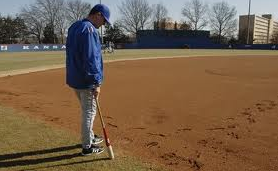In The Heat Of The Moment: Three Ways Climate Change Could Impact The Game Of Baseball
 Since its inception in the mid 1800s, the sport of baseball has grown and evolved, both in its popularity and in the way the game is played.
Since its inception in the mid 1800s, the sport of baseball has grown and evolved, both in its popularity and in the way the game is played.Through the decades, new types of pitches have been developed, different varieties of wood bats have been used, the height of the mound has been altered, and the average distances of outfield fences have been normalized.
But there’s another major factor now being considered that could have a huge impact on the game: climate change.
As the world warms due to accumulating greenhouse gas emissions — changing the atmosphere, altering weather patterns, and impacting the quality of the field — ball players will be forced to adapt to new conditions. Here are three ways that a warming planet could (and in some cases already is) changing the game of baseball.
1. Increasing home runs. As a general rule, its a lot easier to hit in warmer temperatures. The sting from the bat on contact is greatly diminished and balls feel like they go a lot farther in the heat.
In 2004, University of Massachusetts researchers tested the velocity off the bat hitting baseballs cooled to 40 degrees Fahrenheit and heated to 120 degrees Fahrenheit. They found:
The lower the temperature, the slower the ball travel(s) after making contact with the bat. The 40 degree balls traveled at a velocity 2 percent less than the 120 degree balls. This means that a ball that would have traveled 400 feet at 120 degrees would instead travel 392 feet. That can be the distance between a home run and an out.
According to Hardball Times, a very reputable baseball website written by authors well respected in the baseball statistics and analysis world, “over 4% of batted balls leave the ballpark in 75 degree or warmer weather, but that rate drops to about 3.2% in … cold weather conditions.”
2. More difficult fielding. In addition to increasing the frequency and distance of home runs, heat and drought — made worse by climate change — wreaks havoc on baseball fields themselves.
In Atlanta, Georgia, home of the Atlanta Braves, the Turner Field grounds crew has been dealing with 5 years of drought on the infield grass. They finally had to replace it all. According to Braves beat writer Dave O’Brien, the new grass is designed to “slow down” the infield, thereby giving fielders a better shot at catching the ball.
In Atlanta’s outfield, players have been complaining about the ball moving oddly in grass. A recent National Wildlife Federation blog post blames the grass for making the ball “snake” in the outfield, leading to more errors and more runs. Of course, anyone with some decent experience playing in the outfield will tell you that a batted ball “snakes” everywhere. But it is interesting to note that players believe the dry grass exacerbates the issue.
3. Off the field: A greater pool of players. Earlier this week, the first round of the 2012 Major League Baseball First Year Player Draft took place. The first 10 players drafted hail from: Puerto Rico, Georgia, Florida, Louisiana, Northern California, Florida, Southern California, Southern California, Oklahoma, and Alabama, respectively.
Notice that, with the possible exception of San Fransisco, every one of the top 10 amateur baseball players in the country hail from warm weather locals. Its easy to understand why. In places like Florida and Arizona, baseball can be played all year long, while aspiring ballplayers in the Northeast and Northwest have to wait for the snow to melt to start practicing. As the climate changes, it is likely that temperature and precipitation patterns will change as well, resulting in more moderate temperatures in colder regions of the U.S.
A likely result will be more elite level athletes from northern parts of the country. This could have a variety of impacts — ranging from changes in the way northern states fund education and school athletics programs to increased attendance at northern ballparks.
Are any of these changes outlined inherently good or bad for baseball? Its hard to say. The game has changed a lot over the years, and will continue to change. But we can say with certainty that these changes will be bad news for the planet.
You can return to the main Market News page, or press the Back button on your browser.

